What if the input to binary search tree comes in a sorted (ascending or descending) manner? It will then look like this −
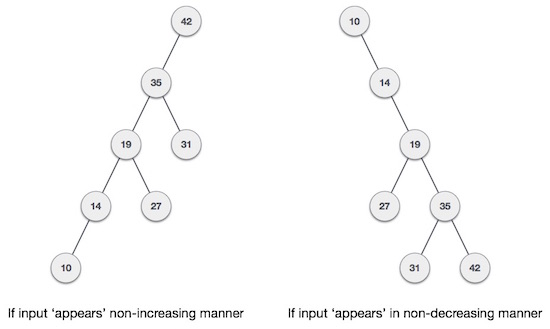
It is observed that BST's worst-case performance is closest to linear
search algorithms, that is Ο(n). In real-time data, we cannot predict
data pattern and their frequencies. So, a need arises to balance out the
existing BST.
Named after their inventor
Adelson,
Velski &
Landis,
AVL trees
are height balancing binary search tree. AVL tree checks the height of
the left and the right sub-trees and assures that the difference is not
more than 1. This difference is called the
Balance Factor.
Here we see that the first tree is balanced and the next two trees are not balanced −
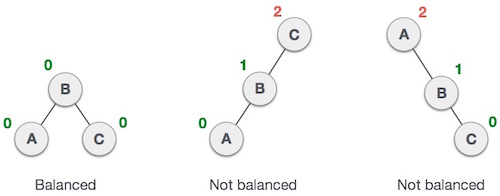
In the second tree, the left subtree of
C has height 2 and the right subtree has height 0, so the difference is 2. In the third tree, the right subtree of
A
has height 2 and the left is missing, so it is 0, and the difference is
2 again. AVL tree permits difference (balance factor) to be only 1.
BalanceFactor = height(left-sutree) − height(right-sutree)
If the difference in the height of left and right sub-trees is more than 1, the tree is balanced using some rotation techniques.
AVL Rotations
To balance itself, an AVL tree may perform the following four kinds of rotations −
- Left rotation
- Right rotation
- Left-Right rotation
- Right-Left rotation
The first two rotations are single rotations and the next two
rotations are double rotations. To have an unbalanced tree, we at least
need a tree of height 2. With this simple tree, let's understand them
one by one.
Left Rotation
If a tree becomes unbalanced, when a node is inserted into the right
subtree of the right subtree, then we perform a single left rotation −
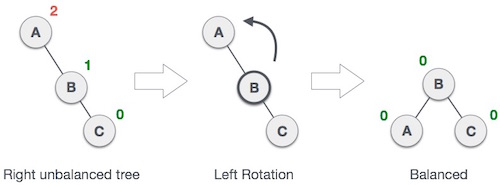
In our example, node
A has become unbalanced as a node is inserted in the right subtree of A's right subtree. We perform the left rotation by making
A the left-subtree of B.
Right Rotation
AVL tree may become unbalanced, if a node is inserted in the left
subtree of the left subtree. The tree then needs a right rotation.
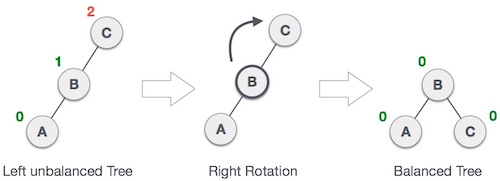
As depicted, the unbalanced node becomes the right child of its left child by performing a right rotation.
Left-Right Rotation
Double rotations are slightly complex version of already explained
versions of rotations. To understand them better, we should take note of
each action performed while rotation. Let's first check how to perform
Left-Right rotation. A left-right rotation is a combination of left
rotation followed by right rotation.
| State |
Action |
 |
A node has been inserted into the right subtree of the left subtree. This makes C an unbalanced node. These scenarios cause AVL tree to perform left-right rotation. |
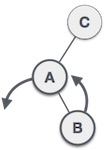 |
We first perform the left rotation on the left subtree of C. This makes A, the left subtree of B. |
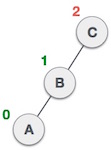 |
Node C is still unbalanced, however now, it is because of the left-subtree of the left-subtree. |
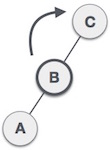 |
We shall now right-rotate the tree, making B the new root node of this subtree. C now becomes the right subtree of its own left subtree. |
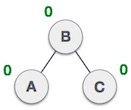 |
The tree is now balanced. |
Right-Left Rotation
The second type of double rotation is Right-Left Rotation. It is a combination of right rotation followed by left rotation.
| State |
Action |
 |
A node has been inserted into the left subtree of the right subtree. This makes A, an unbalanced node with balance factor 2. |
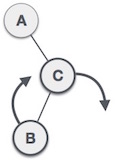 |
First, we perform the right rotation along C node, making C the right subtree of its own left subtree B. Now, B becomes the right subtree of A. |
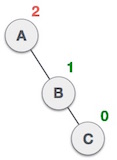 |
Node A is still unbalanced because of the right subtree of its right subtree and requires a left rotation. |
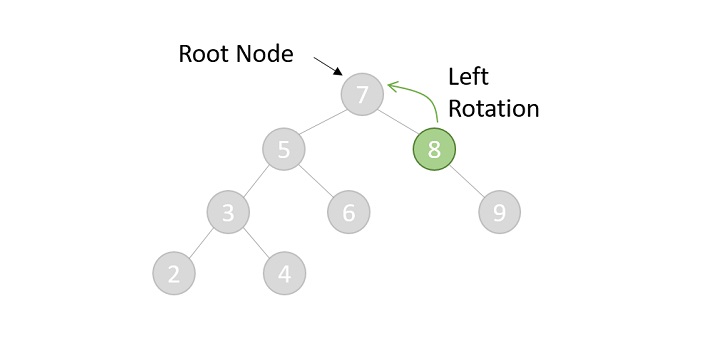 |
A left rotation is performed by making B the new root node of the subtree. A becomes the left subtree of its right subtree B. |
 |
The tree is now balanced. |
 It is observed that BST's worst-case performance is closest to linear
search algorithms, that is Ο(n). In real-time data, we cannot predict
data pattern and their frequencies. So, a need arises to balance out the
existing BST.
It is observed that BST's worst-case performance is closest to linear
search algorithms, that is Ο(n). In real-time data, we cannot predict
data pattern and their frequencies. So, a need arises to balance out the
existing BST. In the second tree, the left subtree of C has height 2 and the right subtree has height 0, so the difference is 2. In the third tree, the right subtree of A
has height 2 and the left is missing, so it is 0, and the difference is
2 again. AVL tree permits difference (balance factor) to be only 1.
In the second tree, the left subtree of C has height 2 and the right subtree has height 0, so the difference is 2. In the third tree, the right subtree of A
has height 2 and the left is missing, so it is 0, and the difference is
2 again. AVL tree permits difference (balance factor) to be only 1. In our example, node A has become unbalanced as a node is inserted in the right subtree of A's right subtree. We perform the left rotation by making A the left-subtree of B.
In our example, node A has become unbalanced as a node is inserted in the right subtree of A's right subtree. We perform the left rotation by making A the left-subtree of B. As depicted, the unbalanced node becomes the right child of its left child by performing a right rotation.
As depicted, the unbalanced node becomes the right child of its left child by performing a right rotation. It is observed that BST's worst-case performance is closest to linear
search algorithms, that is Ο(n). In real-time data, we cannot predict
data pattern and their frequencies. So, a need arises to balance out the
existing BST.
It is observed that BST's worst-case performance is closest to linear
search algorithms, that is Ο(n). In real-time data, we cannot predict
data pattern and their frequencies. So, a need arises to balance out the
existing BST. In the second tree, the left subtree of C has height 2 and the right subtree has height 0, so the difference is 2. In the third tree, the right subtree of A
has height 2 and the left is missing, so it is 0, and the difference is
2 again. AVL tree permits difference (balance factor) to be only 1.
In the second tree, the left subtree of C has height 2 and the right subtree has height 0, so the difference is 2. In the third tree, the right subtree of A
has height 2 and the left is missing, so it is 0, and the difference is
2 again. AVL tree permits difference (balance factor) to be only 1. In our example, node A has become unbalanced as a node is inserted in the right subtree of A's right subtree. We perform the left rotation by making A the left-subtree of B.
In our example, node A has become unbalanced as a node is inserted in the right subtree of A's right subtree. We perform the left rotation by making A the left-subtree of B. As depicted, the unbalanced node becomes the right child of its left child by performing a right rotation.
As depicted, the unbalanced node becomes the right child of its left child by performing a right rotation.










No comments:
Post a Comment